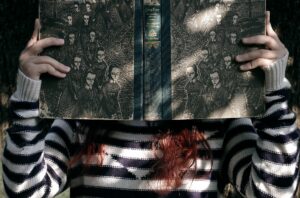A unique family portrait
Story by Adam Justice • Photography by Tina Sargeant
 In 1761, 5-year-old Wolfgang Amadeus Mozart composed his first piece of music. By 17, he was a court musician at Salzburg, playing for the likes of German royalty. Mozart’s father, Leopold Mozart, who was a composer and violinist, took early note of his son’s talent and began nurturing junior’s abilities. Little did Leopold suspect that his son’s aptitude for music would far exceed his own in only five years. The name Mozart is now synonymous with an entire genre of music.
In 1761, 5-year-old Wolfgang Amadeus Mozart composed his first piece of music. By 17, he was a court musician at Salzburg, playing for the likes of German royalty. Mozart’s father, Leopold Mozart, who was a composer and violinist, took early note of his son’s talent and began nurturing junior’s abilities. Little did Leopold suspect that his son’s aptitude for music would far exceed his own in only five years. The name Mozart is now synonymous with an entire genre of music.
Over a century later in 1888, a very young and impressionable Pablo Picasso began his formal training as an artist under the tutelage of his father, José Ruiz y Blasco. Although barely 7 years old, Picasso’s astute ability to draw astounded his father, who was himself an art professor and painter. By the age of 13, Picasso’s artistic ability had surpassed his father’s, forcing the elder to literally withdraw from painting entirely. As we now know, Picasso went on to become one of the most distinctive signifiers of a new era and the most definitive artist in all of modern art.
It’s easy to say that these noted prodigies were somehow predestined with their natural creative abilities. And there may be a bit of truth to that. Or perhaps they were simply born in the right place at the right time. That’s quite plausible. But that all seems too easy, doesn’t it? Giving credit to fate and other such uncontrollable causes doesn’t pass existential muster, especially when addressing something as malleable and personal as artistic dexterity. Surely there is something more pragmatic that can be cited for the early advancement of such exceptional young artists.
I think the answer can begin to be found in heredity. But to inherit a certain skill set isn’t enough; it doesn’t guarantee those skills will continue to be honed as you mature physically, mentally, and emotionally. A nurturing environment is important to ensure the sustenance of natural talent — and not just access to culture, although that’s important, too. It’s more about a degree of extra-personal encouragement to always keep those abilities at the forefront through engagement, practice, and stimulation. It takes an intimate group of like minds to keep a revolving spirit of creative nourishment, feeding on one another to create a collective energy.
 With that said, meet the Joneses, a Lakeland family who not only seem to be gifted with predestined creative abilities, but who also live and thrive by one shared artistic nerve. Just like artistic families before them, including the Mozarts and Picassos, Marty Jones and his two daughters, Sara and Emily, influence each other as immediate relatives and as respective creative individuals. It becomes quickly obvious when speaking to the Joneses that they each rely on the others to complete one creative unit, to the point that it is at times difficult to speak to them individually without referencing the other two. I had the pleasure of meeting with all three of them and witnessing the Jones phenomenon first-hand.
With that said, meet the Joneses, a Lakeland family who not only seem to be gifted with predestined creative abilities, but who also live and thrive by one shared artistic nerve. Just like artistic families before them, including the Mozarts and Picassos, Marty Jones and his two daughters, Sara and Emily, influence each other as immediate relatives and as respective creative individuals. It becomes quickly obvious when speaking to the Joneses that they each rely on the others to complete one creative unit, to the point that it is at times difficult to speak to them individually without referencing the other two. I had the pleasure of meeting with all three of them and witnessing the Jones phenomenon first-hand.
Marty Jones is the third generation to manage Jones & Sons Printing in Lakeland. His grandfather founded the print and design shop in 1952, and Marty is the last remaining “son.” He began working at the print shop in 1981 after growing up in Mulberry. In high school, he experimented with photography and remembers wielding his first camera, a 35mm Praktica, at anything that seemed unconventional.
His first photography gig was with the Mulberry High School yearbook staff. But it wasn’t long before his photography style was admonished for being too fluid for yearbook material. “I guess they couldn’t use photos of trashcans and brickwork,” Marty says with a shrug and a smile. He tempered his creativity for the sake of high school journalism but remained open and experimental with his personal work. Marty continued dabbling in photography but never planned to be an exhibiting photographer.
Eventually, as it does, life intervened, and Marty went to work for his grandfather in the family print business. There, in the early 1990s, he began designing graphics for clients. Although he still occasionally experimented with photography (at one point transforming his bathroom into a darkroom), Marty’s work as a printer and designer kept creativity at the forefront of his daily life. Nowadays, Marty pours most of his creative energies into his two daughters.
The sisters Jones are like dual magnets joined by their opposite polarities. Sara, the older of the two at 19, is an accomplished and easygoing photographer with a penchant for the
unconventional. Perhaps the most telling and immediate sign of her dedicated stance is the 35mm camera she has tattooed on the inside of her right arm. It’s set adjacent to another
tattoo of three circles, each a primary color (red, yellow, and blue), the foremost weapons of any colorist. Sara is without a doubt outspoken in her own unique way, without a lot of excess verbal extravagance. She is a visual person with an aptitude for mathematics, which makes sense given her love for photography as a quantitative medium.
During her “formative years,” Sara was influenced by the photo albums her father had retained of his earlier work. Likewise, Marty’s old camera intrigued her until she began producing her own photographs with disposable cameras. Sara attended Lakeland High School where she remembers fulfilling her physical education requirement online in order to have three art classes as a freshman. Despite baffling the guidance counselor, it was legit. The teachers acknowledged Sara’s reign over the darkroom and granted it her domain. The door of the arts supply closet bore a sign that read “Sara’s Studio.” In all, it was obvious that Sara was neither the typical student nor an apathetic art student.

She has since honed her craft to excel well beyond those disposable cameras of childhood. Sara’s photographs have been exhibited throughout Lakeland at venues such as Arts on
the Park, the former J Rowan Galleries, various Platform Art events, the Lakeland Bus Station, and Polk Museum of Art’s George Jenkins Student Gallery, where she received a Purchase Award.
Sara admits that her current work is fueled by the effects of emotion and memory. These photographs often contain personal sentiments that may not be fully realized by the viewer but are striking nonetheless. Her talent can be clearly seen in the way she stages her photographs, using props or settings that are contextually disconnected but hold a cohesive and attractive whole. To achieve this, Sara simply takes advantage of whatever her present environment may be; she borrows, frames, and reinterprets her surroundings into tight, creative compositions. For her portraits, she often turns to her younger sister to model.
Emily is perhaps the quieter of the two Jones sisters, which is ironic given her inherent musical talents. She is an already seasoned musician at 15. So, her age is no indication of inexperience. Emily has been performing since the age of 8, playing guitar since she was 11. You may have heard her play at Evolution Records, where she has performed countless times, or at The Venue, First Friday events, or Platform Art parties. She released her first EP of original material, titled This Girl, in 2010 and is currently working on a second to be released later this year. She is currently enrolled at Harrison School for the Arts where she studies classical guitar with Dr. Robert Phillips, who assigns her to practice independently for two hours each day. Needless to say, she overachieves.
Emily was drawn to the guitar at an early age. She remembers always being curious about Marty’s 1983 Hondo guitar propped in a corner of their house, until one day she picked it up and just began playing. It was then that Marty said, “We have to do something about this.” Emily was immediately signed up for private guitar lessons. Those early lessons have now led her to be proficient on not only guitar, but also banjo, bass, and ukulele.
But playing an instrument followed Emily’s knack as a singer-songwriter. She has been singing since she was 6 and recorded her first original song at the age of 8. That first recording was written as a fundraiser for her church’s mission trip. It proved far more popular than she had expected. She currently records at a Lakeland studio operated by Christopher Metz and Jeff Hanshaw, aka The Danger Brothers. For her album designs, Emily turns to her reliable Jones cohorts: Marty designs the liner notes and Sara provides the cover art.
Being so talented, and driven to evolve that talent, at such a young age are characteristics of prodigies, and are only enhanced when surrounded by a nurturing environment. As such naturally talented individuals, Emily and Sara find that environment as two measures of a three-part Jones equation. Their father, Marty, completes the trifecta. It’s clear that the Joneses benefit from shared inspiration, enthusiasm, and constructive criticism. As Marty has gladly taken a more supportive role as parent and number-one fan, his obvious belief in and excitement about his daughters’ potential is admirable, commendable, and talented in its own right.
As I sat with the Joneses to prepare for writing this article, while Sara and Emily were lost in sibling conversation, Marty smiled and nudged me, then mouthed the words, “This is really all about them.” I think he concluded the interview best when he looked across the table at his daughters and simply said,
You both are very cool people.
